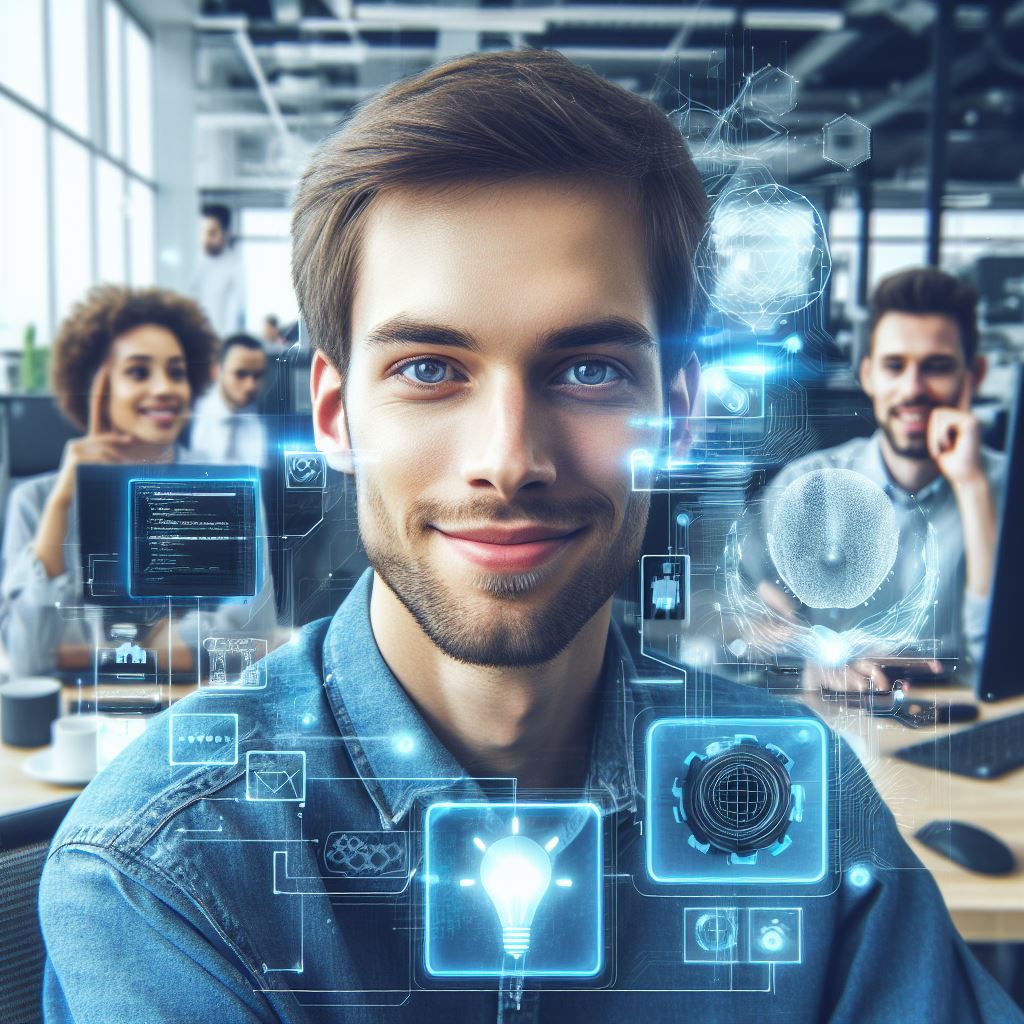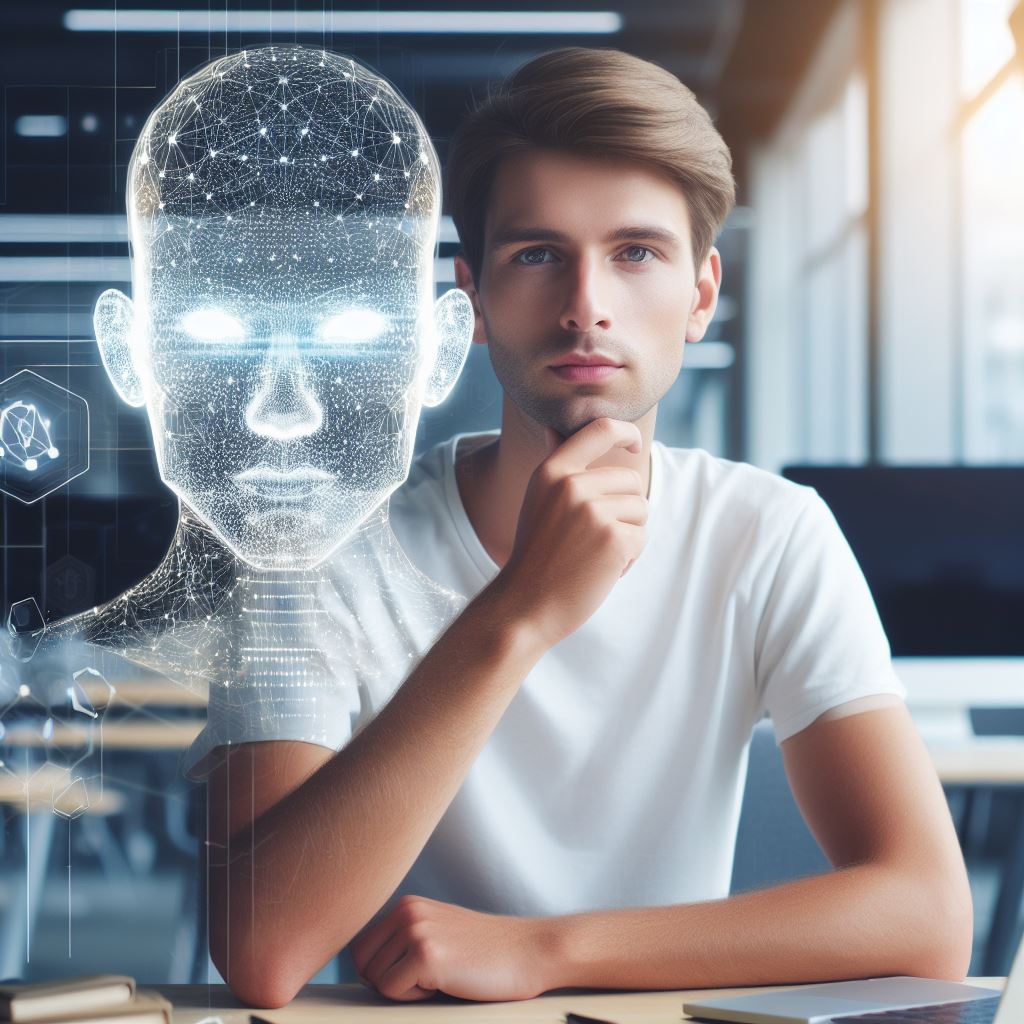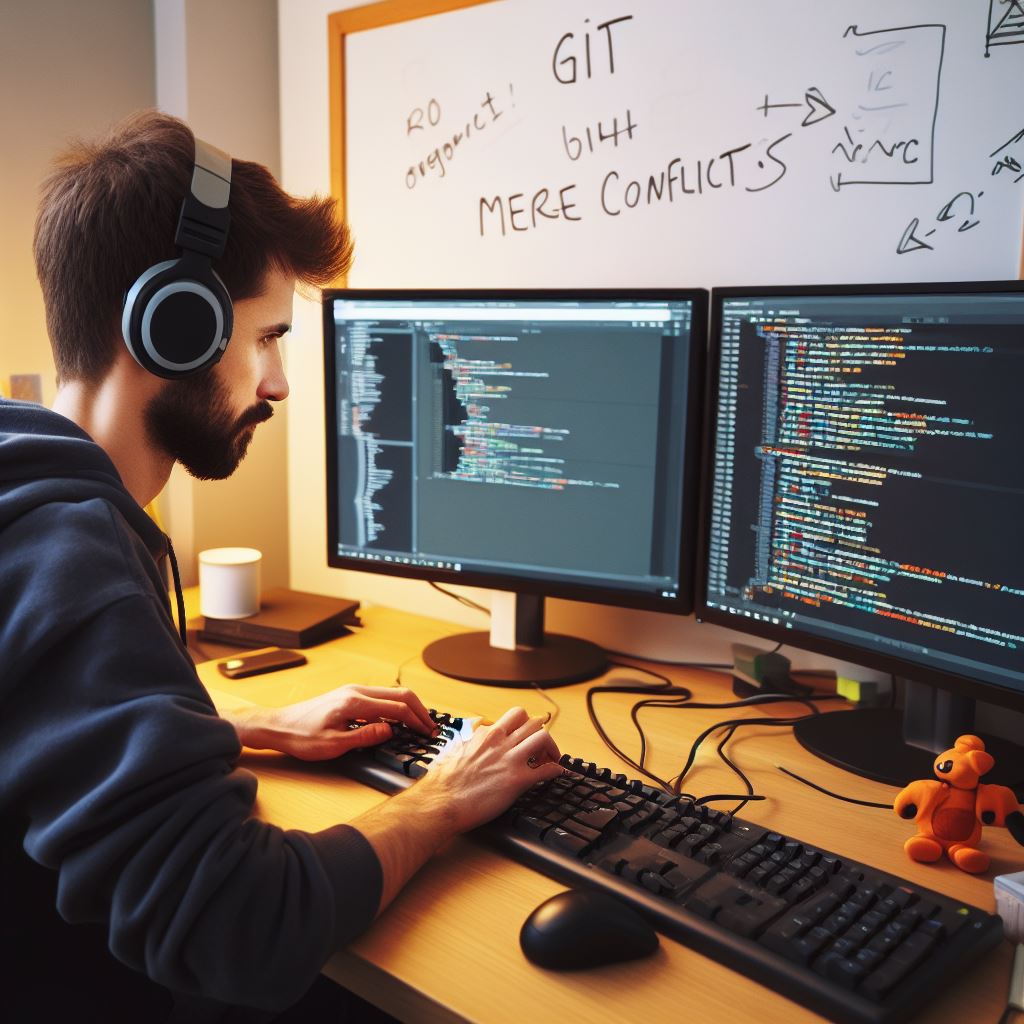Introduction
Definition of AI and IoT
Artificial Intelligence (AI) refers to the development of computer systems capable of performing tasks that typically require human intelligence. This blog post explores AI and IoT.
Internet of Things (IoT) refers to the network of interconnected devices that can exchange data with each other.
Importance and growing prevalence of AI and IoT technologies
The intersection of AI and IoT is increasingly important as it enables smart devices to perform complex tasks.
This technology has become prevalent in various industries including healthcare, manufacturing, and transportation.
Roles of AI and IoT in Smart Devices
Enhancing functionality and automation
AI and IoT technologies work together to enhance the functionality of smart devices.
By analyzing large amounts of data, AI algorithms enable devices to perform tasks without human intervention.
Improving decision-making capabilities
AI and IoT technologies enable smart devices to collect and analyze real-time data, allowing them to make intelligent decisions based on the information they receive.
Enabling predictive maintenance
By continuously monitoring device performance and analyzing data in real-time, AI and IoT technologies can predict when maintenance or repairs are needed, improving the reliability and efficiency of devices.
Enhancing security and privacy
AI and IoT technologies improve the security of smart devices by enabling them to detect and respond to potential threats.
They also enhance privacy by ensuring that personal data is protected and only used for its intended purpose.
Challenges and Future Developments in AI and IoT
Data privacy and security concerns
As AI and IoT technologies continue to advance, concerns surrounding data privacy and security become more prevalent.
Developers and policymakers must address these issues to build trust and ensure user protection.
Ethical considerations
The deployment of AI and IoT technologies raises ethical questions such as accountability, transparency, and bias.
It is crucial to address these concerns to ensure the responsible use of smart devices.
Continued innovation and integration
Looking ahead, the development of AI and IoT technologies will continue to evolve, leading to further integration and innovation.
Tech Consulting Tailored to Your Coding Journey
Get expert guidance in coding with a personalized consultation. Receive unique, actionable insights delivered in 1-3 business days.
Get StartedThis will result in smarter and more efficient smart devices that can adapt to various environments and user needs.
The intersection of AI and IoT is revolutionizing the capabilities of smart devices. As these technologies advance, they will continue to shape industries and improve our daily lives.
It is essential to navigate the challenges and ensure responsible development for a smarter future.
Overview of AI and IoT
AI and its applications
AI, or Artificial Intelligence, refers to the simulation of human intelligence in machines that are programmed to think and learn.
It encompasses a range of technologies such as machine learning and natural language processing. AI has found applications in various fields, including:
- Healthcare: AI is being used to analyze medical data and assist in diagnosing diseases accurately.
- Finance: AI algorithms are employed to detect fraudulent transactions and provide personalized investment recommendations.
- Transportation: Self-driving cars rely on AI to navigate roads and make decisions based on real-time data.
- Customer Service: Chatbots powered by AI are used to deliver instant support and resolve customer queries efficiently.
- Manufacturing: AI-enabled robots are improving productivity and efficiency on factory floors.
Overview of IoT and its significance
IoT, or Internet of Things, refers to the connection of everyday objects to the internet, allowing them to send and receive data.
It enables devices to communicate and interact with each other, leading to new levels of automation and efficiency. IoT has significant implications in various sectors:
- Smart Homes: IoT devices like smart thermostats and security systems enhance convenience and enable remote monitoring.
- Smart Cities: IoT technologies are deployed to manage urban resources efficiently, reduce traffic congestion, and improve public safety.
- Industrial Automation: IoT sensors and actuators enable real-time monitoring, predictive maintenance, and optimization of industrial processes.
- Healthcare: IoT devices allow the monitoring of patients’ health remotely, ensuring timely interventions and personalized care.
- Agriculture: IoT applications help farmers optimize irrigation, monitor soil conditions, and automate crop management for increased yields.
Current trends and advancements in AI and IoT
- Edge AI: AI algorithms are increasingly being deployed on IoT devices themselves, reducing latency and enhancing privacy.
- 5G Connectivity: The advent of 5G networks enables faster and more reliable communication, unlocking the potential of IoT and AI applications.
- Data Analytics: AI-powered analytics platforms are used to extract valuable insights from the vast amounts of data generated by IoT devices.
- AIoT Integration: The convergence of AI and IoT leads to powerful synergies, where AI algorithms enhance the capabilities and intelligence of IoT devices.
- Ethical Considerations: As AI and IoT become pervasive, there is a growing need to address ethical concerns related to privacy, security, and algorithmic bias.
In essence, AI and IoT are two transformative technologies that are revolutionizing various industries. AI brings intelligence and automation, while IoT connects devices and enables data-driven decision-making.
The ongoing advancements in AI and IoT are further pushing the boundaries of what is possible, opening up new opportunities and challenges for the future.
Read: Steps to Turn Coding Skills Into a Career Path
The Synergy between AI and IoT
A successful integration of artificial intelligence (AI) and the Internet of Things (IoT) can bring about incredible advancements in technology.
This section explores how AI enhances IoT devices, the benefits of integrating these technologies, and real-life examples of their integration.
How AI enhances IoT devices
- AI enables IoT devices to learn from data and make intelligent decisions.
- Machine learning algorithms can analyze vast amounts of IoT data and extract valuable insights.
- By leveraging AI, IoT devices can adapt and optimize their performance based on user preferences.
- Cognitive computing capabilities of AI enhance IoT devices’ ability to understand and respond to human interactions.
- The combination of AI and IoT enables predictive maintenance, reducing downtime and extending device lifespan.
Benefits of integrating AI and IoT technologies
- Improved efficiency and productivity as smart devices can automate mundane tasks.
- AI-powered IoT devices can enhance safety by intelligently monitoring and analyzing data in real time.
- The synergy between Artificial Intelligence and the Internet of Things opens new possibilities for personalized and context-aware services.
- Cost savings achieved through optimized resource allocation and predictive maintenance.
- AI and IoT integration enables remote monitoring and control of devices, increasing convenience and accessibility.
Examples of AI and IoT integration in real-life applications
Smart Home Automation
- A home security system that uses AI to analyze video feeds from IoT cameras and send alerts in case of suspicious activities.
- A voice-controlled smart assistant that interacts with IoT devices to control lighting, temperature, and other home appliances.
Healthcare
- Smart wearable devices equipped with AI algorithms monitor vital signs and provide real-time health insights to users and healthcare professionals.
- An AI-powered system that analyzes IoT sensor data to detect patterns and predict potential health issues, facilitating early intervention.
Transportation
- Self-driving cars that utilize AI algorithms to process data from IoT sensors and make real-time driving decisions.
- An intelligent traffic management system that optimizes traffic flow based on data collected from IoT sensors and AI analysis.
Industrial IoT
- AI-enabled predictive maintenance systems that analyze IoT sensor data to detect machinery issues and schedule repairs before failures occur.
- An AI-driven quality control system that monitors production processes using IoT sensors, reducing defects and improving efficiency.
The synergy between Artificial Intelligence and the Internet of Things holds immense potential in revolutionizing various industries and improving our daily lives.
As technology continues to advance, we can expect more innovative applications and solutions emerging from the integration of these two powerful technologies.
Build Your Vision, Perfectly Tailored
Get a custom-built website or application that matches your vision and needs. Stand out from the crowd with a solution designed just for you—professional, scalable, and seamless.
Get StartedRead: How to Use GitHub for AI Project Collaboration
Coding Smart Devices
Importance of coding in building smart devices
In the ever-evolving world of technology, coding plays a crucial role in building smart devices.
Coding enables these devices to interpret and respond to data, making them intelligent and capable of learning.
By writing code, developers can create functionalities and algorithms that make smart devices adaptable and interactive.
Coding empowers smart devices to automate tasks, process information, and communicate with other devices.
Furthermore, coding is pivotal in enabling smart devices to be remotely controlled and connected to the Internet.
Languages commonly used for coding smart devices
When it comes to coding smart devices, several programming languages are commonly employed.
- Python: Known for its simplicity and versatility, Python is often used in IoT projects.
- Java: As a widely-used language, Java offers great scalability and compatibility in smart device development.
- C++: This language is known for its efficiency and is commonly used for resource-intensive smart applications.
- JavaScript: As a scripting language, JavaScript is effective for building responsive smart device interfaces.
- Go: Developed by Google, Go is gaining popularity due to its concurrency features and ease of use.
These languages provide developers with the tools needed to code smart devices efficiently and effectively.
Key considerations and challenges in coding smart devices
While coding smart devices presents immense possibilities, it also entails certain considerations and challenges.
- Security: As smart devices often collect and transmit data, ensuring their security is of utmost importance.
- Memory and Power Constraints: Smart devices have limited resources, requiring efficient code to optimize performance.
- Compatibility: Devices from different manufacturers may have varying hardware, requiring code adaptation.
- Connectivity: Smart devices heavily rely on network connectivity, making robust communication protocols crucial.
- Data Processing: With the influx of data generated by smart devices, efficient data processing is vital.
Developers must carefully address these challenges to create reliable and functional smart devices.
In fact, coding is a fundamental aspect of building smart devices as it enables them to interpret data, automate tasks, and communicate with other devices.
Popular programming languages like Python, Java, C++, JavaScript, and Go are commonly used by developers to code smart devices.
However, certain considerations and challenges, such as security, resource constraints, and compatibility, must be addressed during the coding process.
By overcoming these obstacles, developers can unlock the true potential of smart devices and drive innovation in the field of Artificial Intelligence and the Internet of Things.
Optimize Your Profile, Get Noticed
Make your resume and LinkedIn stand out to employers with a profile that highlights your technical skills and project experience. Elevate your career with a polished and professional presence.
Get NoticedRead: Using AI in Game Development: Practical Coding Tips

AI and IoT in Smart Homes
Overview of AI and IoT applications in smart homes
Artificial Intelligence (AI) and Internet of Things (IoT) technologies are revolutionizing the concept of smart homes.
By integrating Artificial Intelligence and the Internet of Things, homes become more efficient, automated, and capable of understanding and responding to residents’ needs. Here are some key applications:
- Smart home security: AI-powered surveillance systems and IoT-connected sensors ensure robust home security.
- Energy management: AI algorithms analyze data from IoT devices to optimize energy consumption and reduce utility bills.
- Smart appliances: AI-driven home appliances, such as refrigerators and washing machines, offer intuitive interactions and automation.
- Voice assistants: Devices like Amazon Echo and Google Home utilize AI to provide voice-controlled automation and information services.
Examples of smart home devices enhanced by AI and IoT
The collaboration between Artificial Intelligence and the Internet of Things has led to the development of numerous innovative smart home devices. Here are some notable examples:
- Smart thermostats: Devices like Nest Learning Thermostat learn residents’ preferences and adjust temperature accordingly.
- Home security systems: AI algorithms analyze video feeds from IoT cameras to detect and alert homeowners about potential security breaches.
- Smart lighting systems: AI-controlled lights can adapt to residents’ routines, changing colors and brightness levels automatically.
- Automated cleaning robots: AI-powered robots like Roomba navigate homes independently, learning the layout and efficiently cleaning floors.
Future advancements and possibilities in smart home technology
The AI and IoT integration in smart homes is continuously evolving, providing exciting possibilities for the future:
- Enhanced personalization: AI algorithms can learn residents’ habits, preferences, and optimize their living experiences accordingly.
- Improved energy efficiency: Advanced AI algorithms combined with IoT sensors will enable even more precise energy management.
- Health monitoring: IoT devices integrated with AI can monitor residents’ health conditions and provide alerts or suggestions for better well-being.
- Autonomous home management: AI-based systems can take care of household tasks like grocery shopping or appliance maintenance.
As Artificial Intelligence and the Internet of Things technologies continue to advance, the smart home industry will witness even more innovative solutions tailored to consumers’ needs.
The intersection of AI and IoT is shaping the future of smart homes, making them more intelligent, automated, and convenient for users.
Read: Coding Neural Networks: An Introductory Guide
AI and IoT in Healthcare
In recent years, the intersection of Artificial Intelligence (AI) and Internet of Things (IoT) has revolutionized various industries, including healthcare.
This section will explore the applications, benefits, and potential impact of AI and IoT in healthcare monitoring, as well as the ethical considerations and concerns surrounding these technologies.
Applications of AI and IoT in the healthcare industry
One of the significant applications of IoT in healthcare is remote patient monitoring.
By utilizing IoT devices, such as wearable sensors, patients’ vital signs and health data can be continuously collected and transmitted to healthcare providers in real-time.
This real-time data enables early detection of health issues, allowing for prompt intervention and potentially saving lives.
Furthermore, AI algorithms can analyze the collected patient data, including physiological parameters, symptoms, and medical history, to provide accurate diagnoses and treatment recommendations.
This automated analysis assists healthcare professionals in making informed decisions and improves the efficiency of healthcare delivery.
Chronic disease management can also benefit from Artificial Intelligence and the Internet of Things integration.
By monitoring patients’ conditions using IoT devices, healthcare providers can receive notifications and alerts when abnormalities are detected.
This proactive approach enables timely intervention and helps prevent complications.
Moreover, AI-powered chatbots can play a significant role in healthcare. These intelligent virtual assistants can interact with patients, answer their questions, and provide basic medical advice.
By leveraging AI algorithms, chatbots can simulate human-like conversations, enhancing patient engagement and improving access to healthcare information.
Benefits and potential impact of AI and IoT in healthcare monitoring
The continuous monitoring enabled by Artificial Intelligence and the Internet of Things devices has numerous benefits.
Firstly, early detection of health issues through real-time data collection can lead to timely interventions, preventing potential complications.
This proactive approach can significantly improve patient outcomes and increase survival rates.
Additionally, the efficient analysis of patient data by AI systems lowers the risk of medical errors.
AI algorithms can process vast amounts of data quickly and accurately, providing healthcare professionals with valuable insights.
This helps in making evidence-based decisions, reducing misdiagnosis, and improving the efficiency of treatment plans.
Remote patient monitoring also enhances accessibility to healthcare.
Patients residing in remote areas or with limited mobility can receive real-time care and monitor their conditions from the comfort of their homes.
This reduces the need for frequent hospital visits and ensures that healthcare resources are utilized more effectively.
Furthermore, AI-powered predictive analytics can assist healthcare organizations in forecasting disease outbreaks and planning resource allocation accordingly.
By analyzing historical data and current trends, AI algorithms can generate accurate predictions, enabling healthcare providers to allocate resources efficiently and implement preventive measures.
Ethical considerations and concerns related to AI and IoT in healthcare
While Artificial Intelligence and the Internet of Things offer significant benefits, ethical considerations and concerns must be addressed.
Privacy and data security are paramount when dealing with sensitive healthcare data collected by IoT devices.
Implementing robust security measures is essential to safeguard patient privacy and protect against data breaches.
Another concern is the reliance on AI for critical healthcare decisions. Transparency and accountability are crucial to ensure trust in AI-powered systems.
Healthcare professionals should have a clear understanding of how AI algorithms reach their conclusions to make informed decisions and take responsibility for the outcomes.
Furthermore, the potential displacement of healthcare workers due to the automation of certain tasks raises ethical concerns.
While AI and IoT technologies can enhance efficiency, human touch and empathy are irreplaceable in healthcare.
Ensuring a balance between technology and human involvement is vital for ethical healthcare practices.
Lastly, biases in AI algorithms can lead to unequal treatment and exacerbate healthcare disparities.
It is essential to mitigate biases during the development and deployment of AI systems to ensure fair and equitable healthcare outcomes for all individuals.
In short, the integration of AI and IoT in healthcare has the potential to revolutionize the industry.
Through remote patient monitoring, accurate diagnoses facilitated by AI algorithms, and enhanced accessibility to healthcare, Artificial Intelligence and the Internet of Things can significantly improve patient outcomes.
However, to ensure ethical and responsible use of these technologies, privacy, transparency, and fairness must be prioritized.
See Related Content: How to Use Google Cloud Functions: A Beginner’s Guide
Uncover the Details: How Remote Work Boom Makes Coding More Essential
AI and IoT in Smart Cities
Overview of smart city concepts and objectives
Smart cities are urban areas that utilize digital technology and data to enhance the quality of life for its residents and optimize city operations.
The objectives of smart cities include improving efficiency, sustainability, and livability, by seamlessly integrating various systems and services.
Role of AI and IoT in creating smart cities
Artificial Intelligence and the Internet of Things play a crucial role in creating smart cities by enabling efficient data collection, analysis, and automation.
AI algorithms can help analyze vast amounts of data collected by IoT devices, providing valuable insights and enabling proactive decision-making by city officials.
IoT devices, such as sensors and actuators, are integral in capturing real-time data about environmental conditions, energy consumption, transportation, and more.
These devices form the foundation of a smart city’s infrastructure, enabling the collection of data to drive intelligent decision-making.
Case studies of AI and IoT applications in smart city infrastructure
Smart Traffic Management
In a smart city, AI and IoT are used to monitor traffic flow and optimize transportation systems.
AI algorithms analyze data from sensors and cameras placed strategically in the city to detect traffic congestion, accidents, or other road incidents.
Based on this data, smart traffic management systems can adjust traffic signals, reroute traffic, and provide real-time traffic updates for commuters.
Energy Management
AI and IoT technologies play a vital role in optimizing energy consumption and reducing energy wastage in smart cities.
Smart grids equipped with IoT sensors enable real-time monitoring and control of energy distribution, ensuring efficient use of resources and reducing utility costs.
AI algorithms analyze consumption patterns, weather forecasts, and other data to optimize energy production, storage, and distribution based on demand and availability.
Environmental Monitoring
Artificial Intelligence and the Internet of Things solutions are used to monitor and manage environmental conditions in smart cities.
Sensors deployed throughout the city can measure air quality, noise levels, temperature, and humidity, providing real-time data for analysis and decision-making.
AI algorithms analyze this data to identify patterns, detect anomalies, and trigger alerts for necessary actions, such as adjusting traffic flow in polluted areas or managing waste disposal efficiently.
Public Safety
AI and IoT technologies are deployed to enhance public safety in smart cities.
Video surveillance systems equipped with AI-powered video analytics can automatically detect and report suspicious behavior, identify vehicles involved in crimes, or locate missing individuals.
IoT-enabled emergency response systems can provide real-time information and streamline the coordination of emergency services during critical situations.
In general, AI and IoT are fundamental pillars in the development of smart cities, revolutionizing urban living by improving efficiency, sustainability, and safety.
Through their interconnected nature, Artificial Intelligence and the Internet of Things enable data-driven decision-making, optimize resource allocation, and enhance the quality of life for citizens, paving the way for a smarter future.
Conclusion
The intersection of AI and IoT has tremendous potential for creating smart devices.
By combining artificial intelligence with the Internet of Things, we can significantly enhance the capabilities and efficiency of everyday objects.
Throughout this post, we have explored various examples of how AI and IoT work together, including autonomous vehicles, smart homes, and healthcare systems.
These applications demonstrate how coding smart devices can revolutionize numerous industries.
Looking ahead, the future holds even more exciting possibilities for AI and IoT.
With advancements in machine learning and data analytics, smart devices will continue to evolve, offering personalized experiences and improved service quality.
However, along with the potential benefits, there are also challenges to consider. Security and privacy issues need to be addressed to ensure the safe and responsible use of AI and IoT technologies.
Additionally, ethical considerations must be taken into account when coding smart devices to avoid negative impacts on society.
In light of these opportunities and challenges, a call to action is needed. It is crucial for individuals and organizations to delve deeper into the realm of coding smart devices.
Continued exploration and learning will not only contribute to personal and professional growth but also foster innovation and drive positive change in our increasingly interconnected world.
By actively engaging in the intersection of AI and IoT, we can shape a future where intelligent, connected devices enrich our daily lives, sparking a new era of innovation and technological advancement.
So, let us embrace the opportunities that coding smart devices brings.




